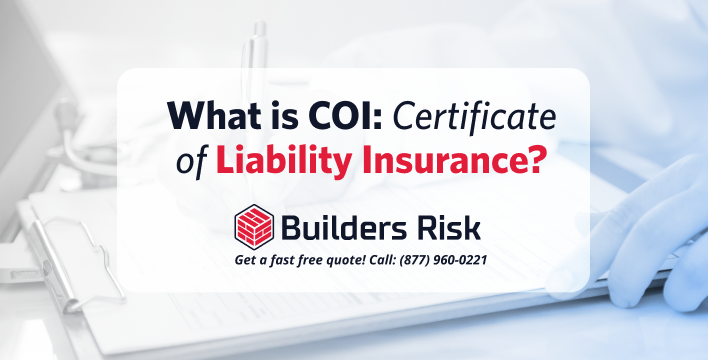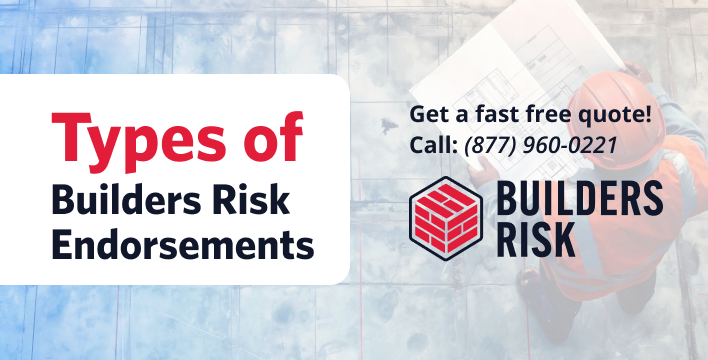
Builders Risk Insurance Costs
August 30, 2024
What is Builder’s Risk Insurance?
September 17, 2024
Builders Risk Insurance Costs
August 30, 2024
What is Builder’s Risk Insurance?
September 17, 2024In the world of business, it is paramount to safeguard oneself from unforeseen risks by staying prepared. Acquiring liability insurance is a prudent step toward demonstrating both prudence and responsibility. However, it is not sufficient to only possess insurance. It is equally essential to furnish evidence of coverage to stakeholders. This is where a Certificate of Liability Insurance (COI) proves to be beneficial.
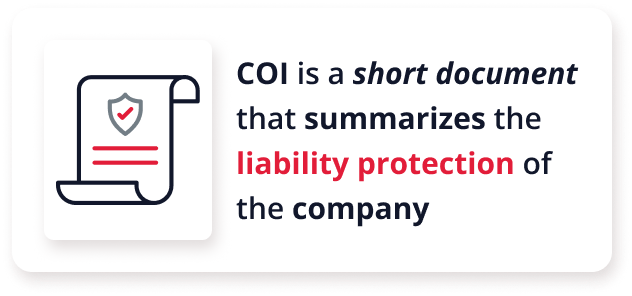
A Certificate of Liability Insurance (COI) is a succinct document that provides a snapshot of an entity’s liability insurance coverage. It serves as verification, a piece of evidence that a business has a valid insurance policy in place, showcasing the types and limits of coverage the policyholder has opted for. Whether you’re a contractor stepping onto a new project site or a vendor entering into a contract, a COI is often your passport to fruitful business engagements.
What Does a COI Typically Include?
A Certificate of Insurance (COI) is a concise yet potent document encapsulating key information about a business’s insurance coverages. Its components serve as a quick reference for third parties to gauge the extent of protection in place. Let’s delve into some fundamental components of a COI:
- Named Insured and Additional Insured:
- Named Insured: This refers to the primary entity or individual covered by the insurance policies listed on the COI. It’s the business or person in whose name the insurance policy is issued.
- Additional Insured: These are other entities or individuals added to the policy, extending certain coverages to them. They might be stakeholders like landlords, clients, or subcontractors whose involvement in the project necessitates some level of insurance protection.
- Policy Limits, Types, and Effective Dates:
- Policy Limits: These represent the maximum amounts an insurer will pay for covered claims. They are crucial as they define the extent of financial protection available.
- Policy Types: The COI lists the types of insurance policies held by the named insured. Common types include General Liability, Auto Liability, Workers’ Compensation, and Umbrella Liability.
- Effective Dates: These are the inception and expiration dates of the policies, providing a clear timeframe within which the coverages are valid.
- Description of Operations, Locations, and Vehicles:
- Description of Operations: This section provides a brief overview of the operations covered under the insurance policies, offering insight into the scope of activities insured.
- Locations: It lists the locations where the coverages apply, which could be project sites, business premises, or other relevant locations.
- Vehicles: If the policy covers auto liability, this section will enumerate the vehicles insured, providing a quick reference to the extent of auto coverage.
Why do companies request a COI?
When companies venture into collaborations, hire contractors, or engage with vendors, a COI is often requested to ensure that the business interactions rest on a foundation of trust and financial security. Below are some pivotal reasons why companies request a Certificate of Liability Insurance:
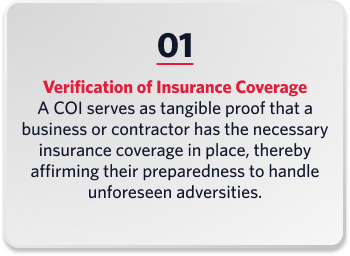
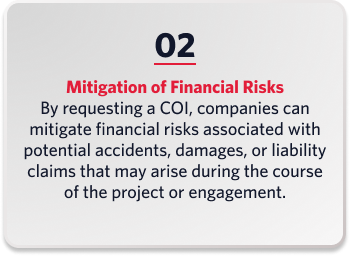
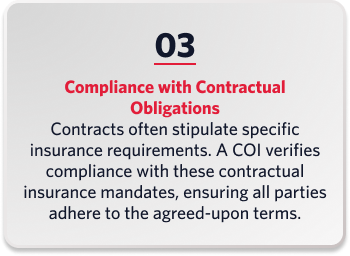
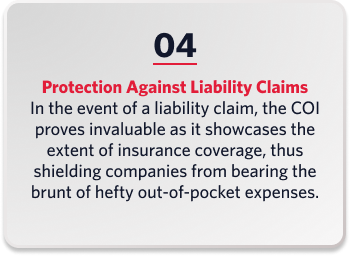
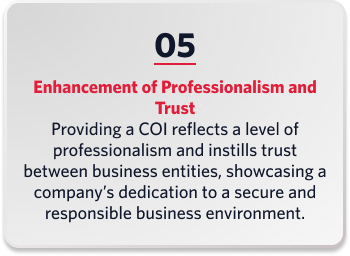
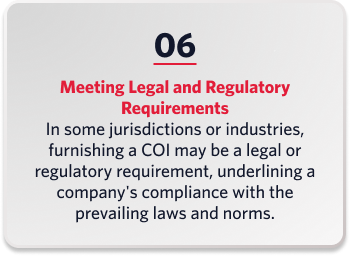
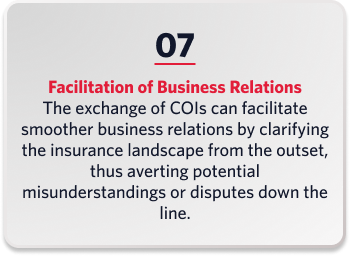
How to verify a COI?
A Certificate of Insurance (COI) stands as a testament to a business’s insurance coverage, acting as a gateway to trust and confidence in professional relationships. However, the trust embedded in a COI hinges on its authenticity. In a world where fraudulent activities are not uncommon, verifying the authenticity of a COI is a prudent step. Here’s how it can be done:
- Steps to Verify the Authenticity of a COI:
- Contact the Insurance Agent or Company: One of the most straightforward ways to verify a COI is by contacting the insurance agent or company listed on the document. They can confirm the accuracy of the information provided.
- Check Policy Numbers and Dates: Ensure that the policy numbers and effective dates listed are accurate and current.
- Verify Named Insured: Confirm that the name and details of the insured party match with the business you are dealing with.
- Review Insurance Coverages: Ensure that the listed coverages meet the requirements necessary for your project or contractual agreement.
- Check for Additional Insured: If you are supposed to be listed as an additional insured, verify that your name or your company’s name is correctly listed.
- Common Red Flags in Fraudulent COIs:
- Inconsistencies in Information: Discrepancies in the information provided, like mismatched names or addresses, can be a red flag.
- Altered or Erased Information: Signs of alteration or erasure on the document may indicate fraudulent activity.
- Unfamiliar Insurance Companies: If the insurance company listed is unfamiliar or has a dubious reputation, it might warrant further investigation.
- Missing or Incorrect Contact Information: Lack of contact information for the insurance agent or company, or incorrect details, can be a sign of fraud.
- Spelling and Grammatical Errors: Professional documents like COIs should be free from spelling or grammatical errors. Such errors can be a sign of a fraudulent document.
- Unusual Policy Limits or Coverages: Extremely high or low policy limits, or coverages that don’t align with industry norms can be suspicious.
Verifying a COI is a step towards fostering a secure and trustworthy business environment. It’s an exercise in due diligence that safeguards against potential fraud, ensuring that the assurance provided by a COI is founded on truth and transparency. By being vigilant and taking the time to verify the authenticity of a COI, businesses can avert potential pitfalls, nurturing a culture of integrity and trust in their professional engagements.
Frequently Asked Questions (FAQ)
A Certificate of Insurance (COI) serves several pivotal purposes in the business realm, acting as a nexus between trust, transparency, and financial security.
A Certificate of Insurance (COI) is a document that provides essential details about insurance policies. For instance, a contractor might have a COI indicating general liability insurance coverage of $1 million per occurrence and $2 million aggregate, auto liability coverage of $1 million, and workers’ compensation as per state laws. The COI would also display the name of the insured, the insurance provider, policy numbers, and effective dates of coverage. It’s a concise snapshot of the contractor’s insurance coverages at a particular time.
The term “COI contract” might be a misnomer as a COI (Certificate of Insurance) and a contract are distinct entities. A COI is a document that evidences insurance coverage, whereas a contract is a formal agreement between parties. However, in business dealings, contracts often require one or more parties to provide a COI as proof of insurance to ensure compliance with the insurance requirements stipulated in the contract. The COI acts as a verification tool to confirm that the required insurance coverages are in place as per the contractual terms.
No, a COI and an insurance policy are not the same. A Certificate of Insurance (COI) is a document that provides a summary of the key terms and conditions of an insurance policy or policies. It provides evidence of insurance coverage, including the types and limits of coverage, the issuing insurance company, the policy number, the named insured, and the policy effective dates.
Related posts

